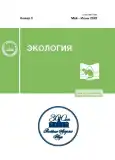A New Method for Determining the Calendar Age of Plants of Heracleum sosnowskyi and Evaluation based on the Age Composition in Cenopopulations of the Species in the North
- Authors: Dalke I.V.1, Maslova S.P.1, Plyusnina S.N.1, Zraychenko E.S.2, Bobrov Y.A.2
-
Affiliations:
- Institute of Biology, Komi Science Center, Ural Branch, Russian Academy of Sciences
- Syktyvkar State University
- Issue: No 3 (2023)
- Pages: 212-219
- Section: Articles
- URL: https://journals.rcsi.science/0367-0597/article/view/139187
- DOI: https://doi.org/10.31857/S0367059723030022
- EDN: https://elibrary.ru/EARBLW
- ID: 139187
Cite item
Full Text
Abstract
Studies have been carried out to determine the calendar age of plants of the invasive species Hogweed Sosnovsky (Heracleum sosnowskyi Manden.). The study of the root structure showed the presence of growth rings formed by increments of secondary xylem, which makes it possible to use the xylochronological approach to estimate the calendar age of H. sosnowskyi. The number of xylem rings on the transverse section of the root corresponds to the number of remnants of annual increments on the longitudinal section of the underground caudex. The method of accounting for annual increments on a longitudinal section of the caudex is simple and effective and allows you to determine the age of plants of H. sosnowskyi in the field, without resorting to tissue contrast and microscopy. Plants of H. sosnowskyi in natural cenopopulations of the middle taiga zone of the Komi Republic, started flowering in the third year of life, and their calendar age reached 7 full years.
About the authors
I. V. Dalke
Institute of Biology, Komi Science Center, Ural Branch, Russian Academy of Sciences
Email: dalke@ib.komisc.ru
Syktyvkar, Russia
S. P. Maslova
Institute of Biology, Komi Science Center, Ural Branch, Russian Academy of Sciences
Email: dalke@ib.komisc.ru
Syktyvkar, Russia
S. N. Plyusnina
Institute of Biology, Komi Science Center, Ural Branch, Russian Academy of Sciences
Email: dalke@ib.komisc.ru
Syktyvkar, Russia
E. S. Zraychenko
Syktyvkar State University
Email: dalke@ib.komisc.ru
Syktyvkar, Russia
Yu. A. Bobrov
Syktyvkar State University
Author for correspondence.
Email: dalke@ib.komisc.ru
Syktyvkar, Russia
References
- Kattge J., Boenisch G., Diaz S. et al. TRY plant trait database – enhanced coverage and open access // Global Change Biology. 2020. V. 26. № 1. P. 119–188. https://doi.org/10.1111/gcb.14904
- Работнов А.Т. Методы определения возраста и длительности жизни у травянистых растений // Полевая геоботаника. М.;Л.: Изд-во АН СССР, 1960. Т. 2. С. 249–262.
- Жукова Л.А. Многообразие путей онтогенеза в популяциях растений // Экология. 2001. №. 3. С. 169–176.
- Dietz H., Ullmann I. Age-determination of dicotyledonous herbaceous perennials by means of annual rings: exception or rule? // Annals of Botany. 1997. V. 80. P. 377–379. https://doi.org/10.1006/anbo.1997.0423
- Schweingruber F.H., Poschlod P. Growth rings in herbs and shrubs: life span, age determination and stem anatomy // Forest Snow and Landscape Research. 2005. V. 79. № 3. P. 195–415.
- Степанова А.В. Ксилохронология травянистых и полудревесных двудольных растений // Ботан. журн. 2011. Т. 96. № 6. С. 673–680.
- Harper J.L., White J.E. The Demography of Plants // Ann. Rev. of Ecology, Evolution, and Systematics. 1974. V. 5. P. 419–463. https://www.jstor.org/stable/2096894
- Ценопопуляции растений (основные понятия и структура) / Смирнова О.В., Заугольнова Л.Б., Ермакова И.М. и др. М.: Наука, 1976. 216 с.
- Rejmanek M., Richardson D.M. What attributes make some plant species more invasive? // Ecology. 1996. V. 77. P. 1655–1661. https://doi.org/10.2307/2265768
- Chadin I., Dalke I., Zakhozhiy I. et al. Distribution of the invasive plant species Heracleum sosnowskyi Manden. in the Komi Republic (Russia) // PhytoKeys. 2017. V. 77. P. 71–80. https://doi.org/10.3897/phytokeys.77.11186
- Болотова Е.С. Продолжительность жизни борщевика Сосновского в условиях культуры в центральной зоне Коми АССР // Биологические исследования на северо-востоке европейской части СССР (Ежегодник). Сыктывкар, 1974. С. 54–59.
- Сацыперова И.Ф. Борщевики флоры СССР – новые кормовые растения. Л.: Наука, 1984. 223 с.
- Pergl J., Perglová I., Pyšek P., Dietz H. Population age structure and reproductive behaviour of the monocarpic perennial Heracleum mantegazzianum (Apiaceae) in its native and invaded distribution ranges // American Journal of Botany. 2006. V. 93. № 7. P. 1018–1028. https://bsapubs.onlinelibrary.wiley.com/doi/full/10.3732/-ajb.93.7.1018
- Hüls J., Otte A., Eckstein R.L. Population life-cycle and stand structure in dense and open stands of the introduced tall herb Heracleum mantegazzianum // Biological Invasions. 2007. V. 9. № 7. P. 799-811. https://doi.org/10.1007/s10530-006-9082-9
- Nehrbass N., Winkler E., Müllerová J. et al. A simulation model of plant invasion: long-distance dispersal determines the pattern of spread // Biological Invasions. 2007. V. 9. P. 383–395. https://doi.org/10.1007/s10530-006-9040-6
- Chadin I., Dalke I., Tishin D. et al. A simple mechanistic model of the invasive species Heracleum sosnowskyi propagule dispersal by wind // PeerJ. 2021. 9:e11821. https://doi.org/10.7717/peerj.11821
- Безделев А.Б., Безделева Т.А. Жизненные формы семенных растений российского Дальнего Востока. Владивосток: Дальнаука, 2006. 296 с.
- Товстик Е.В., Адамович Т.А., Ашихмина Т.Я. Идентификация участков массового роста борщевика Сосновского с помощью спектральных индексов по данным Sentinel-2 // Теоретическая и прикладная экология. 2019. № 3. С. 34–40. https://doi.org/10.25750/1995-4301-2019-3-034-040
- Далькэ И.В., Захожий И.Г., Чадин И.Ф. Распространение борщевика Сосновского и мероприятия по его ликвидации на территории МО ГО “Сыктывкар” (Республика Коми) // Вестник Института биологии Коми НЦ УрО РАН. 2018. № 3(205). С. 2–13. https://doi.org/10.31140/j.vestnikib.2018.3(205).1
- Ламан Н.А., Прохоров В.Н., Масловский О.М. Гигантские борщевики – опасные инвазивные виды для природных комплексов и населения Беларуси. Минск: Ин-т экспериментальной ботаники им. В.Ф. Купревича НАН Беларуси, 2009. 40 с.
- Барыкина И.П., Веселова Т.Д., Девятов А.Г. Справочник по ботанической микротехнике. Основы и методы: Учеб. пособие. М., 2004. 312 с.
- Чадин И.Ф., Далькэ И.В., Малышев Р.В. Оценка морозостойкости борщевика Сосновского (Heracleum sosnowskyi Manden.) после удаления снежного покрова в ранневесенний период // Российский журн. биологич. инвазий. 2018. № 4. С. 105–116.
- Tappeiner U., Cernusca A. Model simulation of spatial distribution of photosynthesis in structurally differing plant communities in the Central Caucasus // Ecological Modelling. 1998. V. 113. № 1. P. 201–223. https://doi.org/10.1016/S0304-3800(98)00144-6
- Dalke I.V., Chadin I.F., Zakhozhiy I.G. et al. Traits of Heracleum sosnowskyi plants in monostand on invaded area // PLOS ONE. 2015. N. 10 (11). P. e0142833. https://doi.org/10.1371/journal.pone.0142833
Supplementary files














